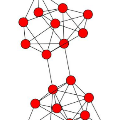Learning low-level node embeddings using techniques from network representation learning is useful for solving downstream tasks such as node classification and link prediction. An important consideration in such applications is the robustness of the embedding algorithms against adversarial attacks, which can be examined by performing perturbation on the original network. An efficient perturbation technique can degrade the performance of network embeddings on downstream tasks. In this paper, we study network embedding algorithms from an adversarial point of view and observe the effect of poisoning the network on downstream tasks. We propose VIKING, a supervised network poisoning strategy that outperforms the state-of-the-art poisoning methods by upto 18% on the original network structure. We also extend VIKING to a semi-supervised attack setting and show that it is comparable to its supervised counterpart.
翻译:使用网络代表性学习技术的学习低层次节点嵌入,对于解决节点分类和链接预测等下游任务非常有用。这些应用中的一个重要考虑因素是嵌入算法对于对抗性攻击的稳健性,可以通过对原始网络进行干扰来检查。一种有效的扰动技术可以降低网络嵌入下游任务的性能。在本文中,我们从对立角度研究网络嵌入算法,并观察毒害网络对下游任务的影响。我们建议VIKING, 一种监管网络中毒战略,在原始网络结构上比最先进的中毒方法高出18%。我们还将VIKINGE扩大到半监视攻击设置,并显示它与其监督对手相近。



